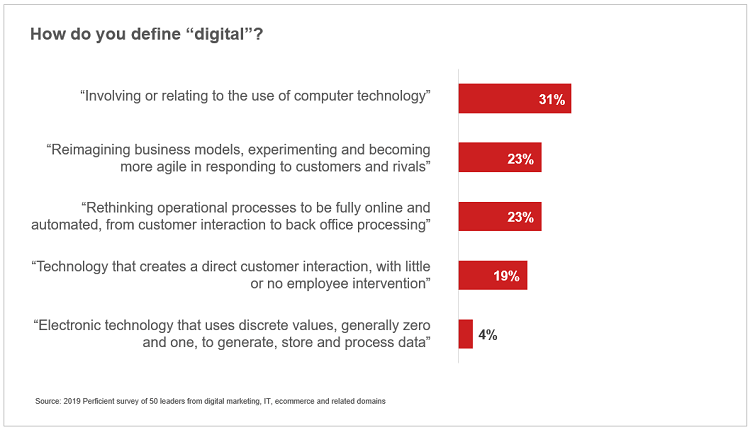When you hear “digital,” what comes to mind? A smartphone? Your Twitter feed? Maybe this morning’s Peloton session you absolutely crushed? Or perhaps it’s live-editing a Google document with teammates in multiple time zones. Or using AI to coax meaning out of data that not long ago you thought to be worthless.
Digital can be many things. Whatever you think it is, chances are your definition doesn’t match that of your peers. (More on why this may be a bad thing in a moment.) In business today, linking the word “digital” to fundamental and dramatic change has become commonplace; see phrases starting with “digital” and ending in “disruption,” “transformation,” and “reinvention.” It’s been nearly a decade since Marc Andreessen announced “software is eating the world,” and so far its appetite shows no sign of waning. Since Andreessen’s proclamation, nearly every industry and company has been affected by the transformative power of digital. We know digital (or think we know it) because we’ve seen its powerful, permeating effects.
A World of Digital
But if digital is everywhere and everything is digital, the concept is at risk of being overgeneralized, and overgeneralization risks misunderstanding. As users, we carry around expectations of things we know to be digital. These expectations are shaped by our first-hand experiences. Yet, I’d bet you’d agree that for any organization that relies on digital to stay relevant – which is just about all of them – it’s important to have a shared understanding of the term extending beyond personal experience. In fact, a 2018 McKinsey & Co. paper blamed “fuzzy definitions” of digital as the number one reason for the failure of digital strategies. Its authors said, “lacking a clear definition of digital, companies struggle to connect digital strategy to their business, leaving them adrift in the fast-churning waters of digital adoption and change.”
So with all this in mind, we set out to learn: What is digital? After polling 50 Perficient clients, peers, and other digital decision-makers on this question, we’re ready to share our learnings.
Our survey included questions on four topics:
- How do you define “digital”?
- What innovations and capabilities do you associate with digital?
- What benefits do you expect from increased digital maturity?
- How have your attitudes toward digital changed in the past few years?
Defining Digital
To begin seeing how people are defining digital, we asked survey respondents to consider five definitions of the word “digital.” We then asked them to choose the one that best matched their understanding of the term. In drafting the candidate definitions, we predicted one would win out easily over all the others. Respondents instead surprised us in how evenly divided they were across their selections.
The most popular definition turned out to be “involving or relating to computer technology.” This was the broadest and most straightforward of the five. The next most popular packed more punch and included the phrase “reimagining business models, experimenting and becoming more agile.” Tied for second was digital as “a rethinking of operational processes to be online and automated.” Next in line: “technology that creates direct customer interactions,” and coming in last, a more standard “ones and zeros” dictionary definition that ended up being preferred by just a few respondents.
Looking across the responses, themes of people and change are consistently reflected. Two-thirds of participants opted for a definition that includes the word “customer.” And more than 40% selected definitions containing the convention-challenging “rethinking” and “reimagining.” Another interesting finding: we looked for preference patterns but found little correlation between participants’ age groups, roles, and industries and the descriptions they chose. Apparently the very definitions of “digital” also run counter to categorical conventions.
In the second installment of this series, we’ll explore the benefits expected of digital, the types of innovations associated with digital, and changes in attitudes toward digital in recent years.


The digital world is all around us, but in order to really understand it, it helps to accurately define it. It is so interesting to read about people’s varied responses because it is valuable to know how people really see it.